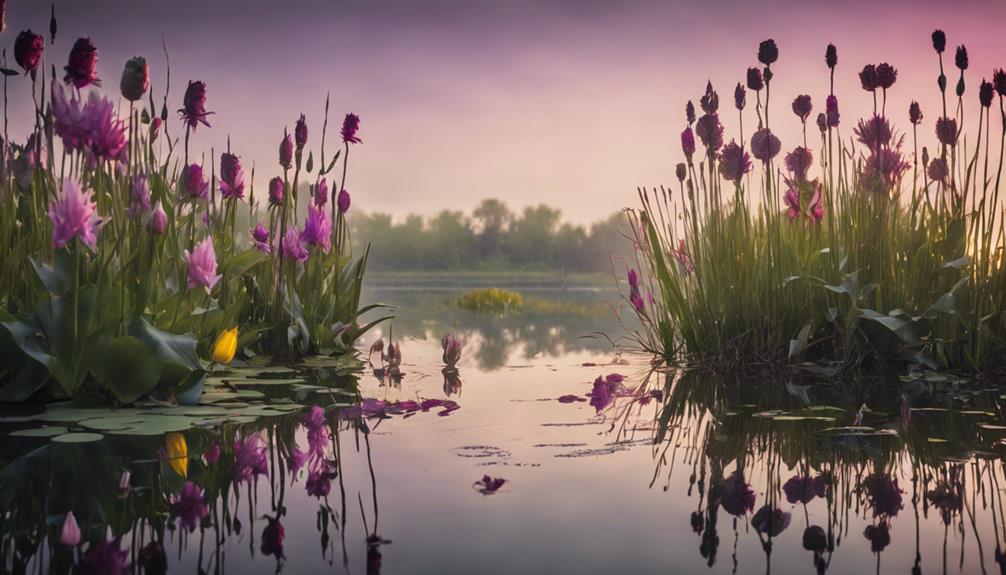You face a unique set of challenges when selecting plants for a beautiful water's edge, where fluctuating water levels, intense sunlight, and saturated soil demand careful consideration. Native plants are a great choice, as they're naturally equipped to handle these conditions and prevent erosion with their deep roots. Choose plants that can tolerate periodic flooding and drought, such as Blue Flag Iris, Common Arrowhead, and Golden Creeping Jenny. Select low-maintenance options that thrive in moist soil, like Canna Lily, Pink Muhly Grass, and Hosta. By choosing the right plants, you'll create a thriving, beautiful landscape that requires minimal upkeep – and there's more to explore to achieve the perfect balance of aesthetics and function.
Table of Contents
Key Takeaways
- Choose native plants that can tolerate fluctuating water levels, intense sunlight, and saturated soil for a thriving water's edge.
- Select plants with deep roots to stabilize soil and prevent erosion, such as native perennials and evergreen trees.
- Consider low-maintenance plants like native perennials, evergreen trees, and shrubs that require minimal pruning and care.
- Incorporate plants that provide texture and visual interest, such as ornamental grasses and Creeping Jenny, to create a dynamic landscape.
- Plant a diverse palette of native plants that attract pollinators and wildlife, while also stabilizing soil and filtering water.
Understanding Water's Edge Conditions
As you approach the water's edge, you'll encounter a unique combination of environmental factors, including fluctuating water levels, intense sunlight, and saturated soil, that demand careful consideration when selecting plants for this challenging zone.
The waters edge is a dynamic environment where water levels can drop or rise dramatically, exposing or submerging plants. This constant change requires plants that can adapt to varying levels of moisture and light.
The moist soil at the water's edge is prone to erosion, making it essential to choose plants with deep roots that can stabilize the soil.
Native plants, which have evolved to thrive in this environment, are an excellent choice. They're naturally equipped to handle the intense sunlight and saturated soil, and their deep roots help prevent erosion.
To thrive in this zone, plants must be able to tolerate periodic flooding and drought.
Choosing Native Plants Wisely
When selecting native plants for the water's edge, to guarantee their survival and success, choose species that are specifically adapted to the local climate, soil conditions, and moisture levels. By doing so, you'll create a thriving ecosystem that benefits both the environment and your property. Native plants have extensive root systems that stabilize soil and prevent erosion, absorb pollutants and excess nutrients from the water, and provide habitat and food sources for local wildlife.
Some benefits of choosing native plants for your water's edge:
| Benefits | Description |
|---|---|
| Soil Stabilization | Prevents erosion and landslide |
| Water Quality Improvement | Absorbs pollutants and excess nutrients |
| Wildlife Habitat | Provides food and shelter for local species
Moist Soil Plant Options
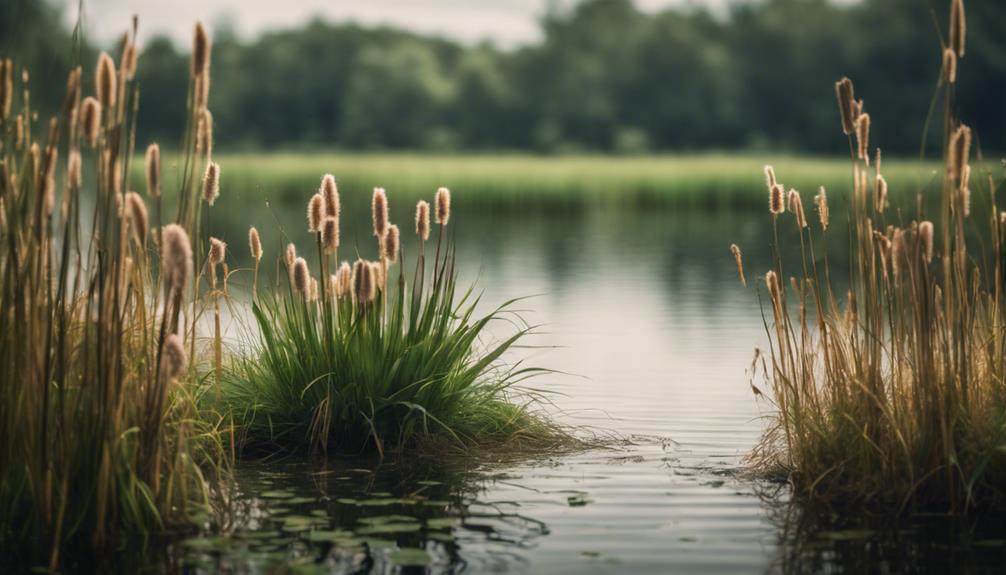
You'll find a diverse range of plants that thrive in moist soil, from dramatic Elephant Ears to vibrant Golden Creeping Jenny, each offering unique textures, colors, and growth habits to enhance your water's edge landscape.
Elephant Ears, with their exotic appearance, can add a touch of drama to your pond area, tolerating partial shade to full sun.
For a burst of color, consider Canna Lily, which can grow up to 6 feet tall and comes in shades of red, yellow, and orange.
Pink Muhly Grass creates a soft, feathery texture with its airy pink flower plumes, adding a delicate touch to your water's edge.
Hosta, with its large, decorative foliage, can grow up to 3 feet tall and 5 feet wide, making it an excellent groundcover choice.
Golden Creeping Jenny, on the other hand, forms a vibrant carpet around the pond, tolerating occasional wet feet.
Low-Maintenance Water's Edge Plants
Low-maintenance plants are a great choice for the water's edge, offering a hassle-free way to achieve a beautiful and thriving landscape. As you select plants for your water's edge, think about native plant species that require minimal upkeep. These plants have adapted to the local climate and soil conditions, making them ideal for the water's edge.
Native plants are a great option for the water's edge, offering a low-fuss way to achieve a beautiful and thriving landscape.
| Plant Type | Species | Ease of Care |
|---|---|---|
| Native Perennials | Blue Flag Iris, Common Arrowhead | Low maintenance, requires occasional pruning |
| Evergreen Trees | Red, Silver, and Sugar Maples | Tolerant of moist conditions, minimal pruning required |
| Low-Maintenance Shrubs | Japanese Garden Juniper, Creeping Juniper | Hardy, drought-tolerant, and require minimal care
Adding Texture With Unique Plants
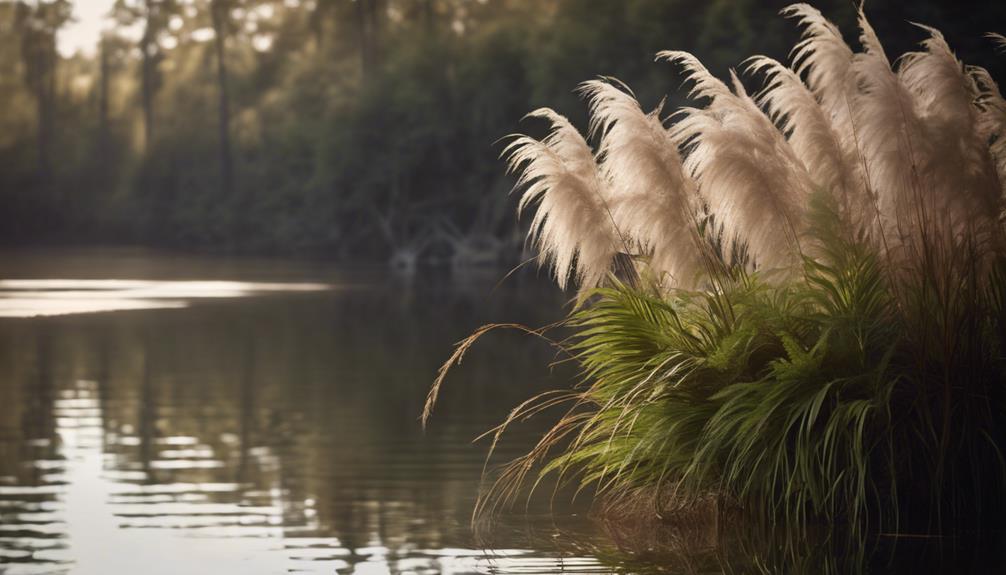
As you design your water's edge landscape, you'll want to incorporate plants that add dynamic texture to the space.
To achieve this, focus on selecting species that boast foliage with movement, such as ornamental grasses or irises, which will create a sense of energy near the water.
Foliage With Movement
Planting species with foliage that undulates in the breeze adds a mesmerizing layer of texture to your water's edge, drawing the eye to the dynamic interplay between plant and water.
You can create an enchanting scene by incorporating plants with foliage that moves gently in the wind. One such species is Creeping Jenny, whose golden, coin-shaped leaves cascade down the water's edge, creating a lush greenery that appears to flow like a river.
The movement of the foliage creates a sense of energy and dynamism, adding depth and visual interest to your water feature.
When selecting plants with foliage with movement, consider the direction of the breeze and how it will affect the plant's movement. You want to position the plants in a way that maximizes the visual impact of the movement.
Whimsical Water Lilies
You can add an extra layer of sophistication to your water's edge by introducing whimsical water lilies, whose delicate, fragrant blooms and varied textures create a mesmerizing display of color and movement on the pond's surface. With their elegant appearance, water lilies can elevate your water feature, making it a stunning focal point in your outdoor space.
Burgundy Princess and Pink Beauty are ideal for adding a touch of elegance in zones 4-11.
Hardy Water Lily is a low-maintenance option that tolerates varying water depths and produces white, yellow, or pink flowers.
Native Water Lilies like Nymphaea odorata and Nymphaea alba support a healthy ecosystem and provide shade for aquatic life.
Tropical Water Lily offers vibrant, exotic blooms, but be prepared for more maintenance and potential replanting in zones with freezing temperatures.
These popular varieties are worth exploring:
Sensual Stem Textures
Beyond the stunning blooms of water lilies, you can further enrich your water's edge by incorporating plants with unique, sensual stem textures that add depth and visual interest to your outdoor space.
One option is Papyrus, which adds a tropical touch with its tall, slender stems growing up to 6 feet tall in zones 9-11.
For a more subtle look, the Golden Variegated Sweet Flag features green and gold striped foliage that brightens shady areas near the pond, adding a unique textural element with its sword-shaped leaves.
Switchgrass provides vertical interest and winter texture, preferring moist soil with good drainage, and its airy plumes create a soft, feathery texture.
Rice Paddy Grass adds a unique textural element and can be grown in containers placed at the water's edge, with its delicate, drooping stems and tiny flowers.
Water Bamboo thrives in moist soil and adds a touch of whimsy to the pond area, with its hollow, jointed stems that resemble miniature bamboo.
Creating a Thriving Ecosystem
How do you envision a thriving ecosystem unfolding along the water's edge, where native plants work in harmony to stabilize soil, protect water quality, and provide habitat for fish and wildlife?
By choosing the right native plants for your specific water's edge conditions, you can create a beautiful and thriving ecosystem that benefits both humans and wildlife.
Four key benefits of native plants are:
Native plants establish quickly: They require less maintenance and upkeep, making them an ideal choice for creating a thriving ecosystem.
Habitat for fish and wildlife: Native plants provide key habitat for fish and wildlife, and absorb and lessen energy from waves.
Water quality protection: Native plants help to slow down water runoff, allowing pollutants and sediments to settle out or be absorbed.
Diverse and resilient ecosystem: Planting a diverse range of native plants will create a thriving ecosystem that's resilient to changes in water levels and moisture conditions.
Plant Selection for Climate Zones
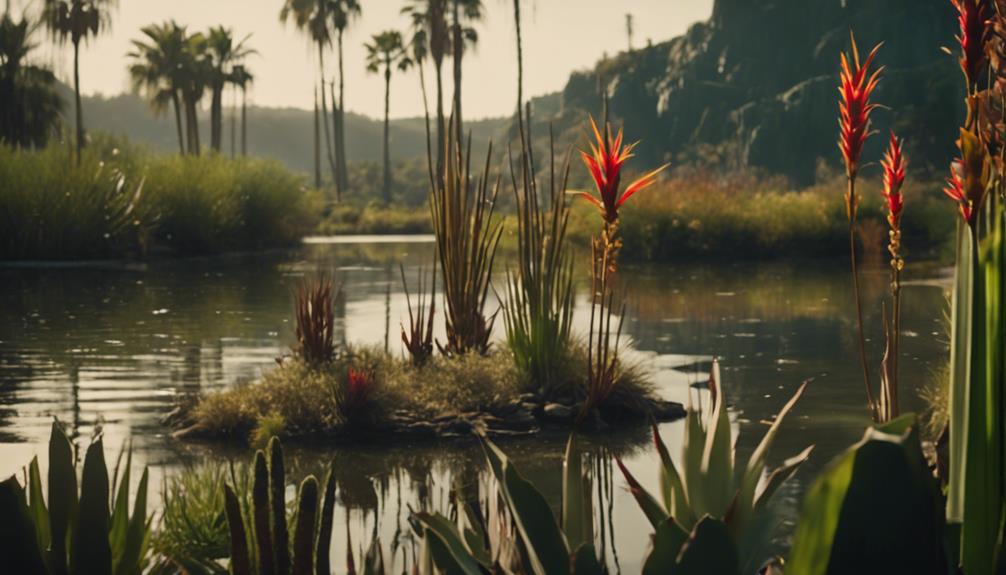
As you tailor your water's edge ecosystem to thrive in specific climate conditions, selecting plants that match your zone is vital to creating a resilient and diverse environment. Your local climate plays a significant role in determining the types of plants that will flourish in your pond area. Choosing plants that are suitable for your zone guarantees they can withstand temperature fluctuations, sunlight exposure, and soil type.
Here's a breakdown of plants suitable for different zones:
| Zone | Plant Options | Characteristics |
|---|---|---|
| 8-11 | Cardinal Flower, Golden Variegated Sweet Flag | Thrive in moist soil, attract hummingbirds and butterflies |
| 5-7 | Siberian Iris | Add color in late spring and early summer, prefer moist soil with good drainage |
| 1-4 | Siberian Bugloss, Switchgrass | Tolerate moist soil and winter conditions, add elegance and texture |
| All | Consider temperature, sunlight, and soil type | Facilitate plants' survival and success |
Attracting Pollinators and Wildlife
By incorporating plants that provide nectar, seeds, and shelter, you can attract a diverse range of pollinators and wildlife to your water's edge ecosystem. This not only enhances biodiversity but also creates a vibrant and dynamic environment that's teeming with life.
Plant native flowers with bright colors, such as coneflowers, black-eyed susans, and cosmos, which attract pollinators like bees, butterflies, and hummingbirds.
Incorporate native grasses and sedges that provide shelter and habitat for local wildlife, including birds, frogs, and insects.
Add plants with berries or seeds, like shrubby dogwoods and buttonbush, which offer a food source for wildlife during the winter months.
Create a diverse plant palette that includes plants with different bloom times, ensuring a constant source of nectar and pollen for pollinators throughout the growing season.
Planting for Aesthetics and Function
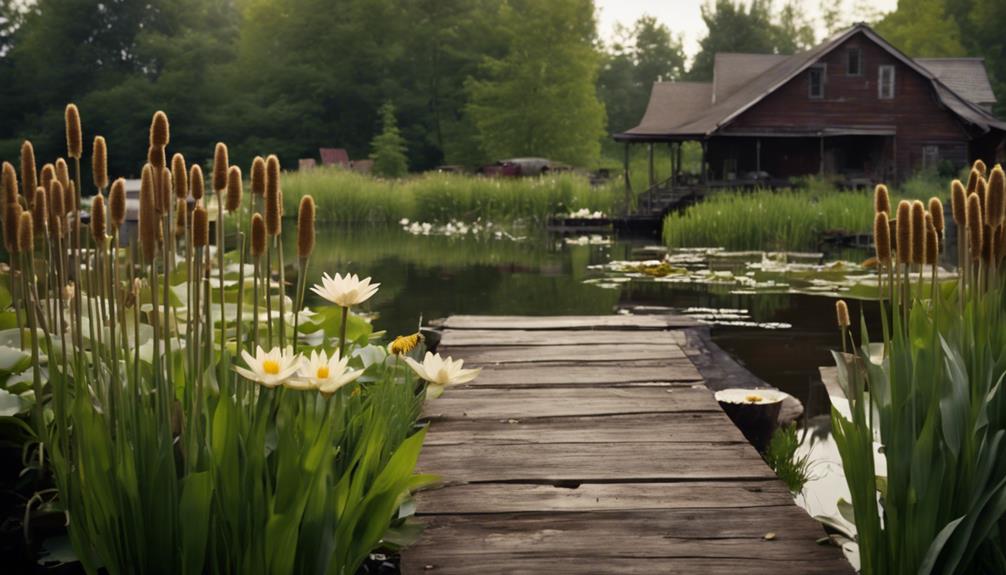
As you design your water's edge plantings, you'll want to balance visual appeal with functional considerations.
You'll need to choose plants that not only provide beauty and texture but also serve a purpose, such as stabilizing soil or filtering water.
Visual Appeal Matters
Your waterfront landscape should be a masterpiece of form and function, where native plants like Blue Flag Iris, Common Arrowhead, and Wild Bergamot combine to create a natural, effortless aesthetic that stabilizes soil and enhances habitat for fish and wildlife.
To achieve visual appeal, consider the following:
Varying heights and textures: Mix trees, shrubs, flowers, grasses, and sedges to create a dynamic landscape.
Bursts of color: Incorporate plants like Cardinal Flower, Japanese Iris, and Sweet Flag, which add vibrant colors, striking foliage, and elegant blooms.
Splash of color at different times: Choose plants with varying bloom times to create interest throughout the growing season.
Visual flow: Consider plant height, spread, and bloom times to maintain access, views, and aesthetics while protecting water quality and habitat.
Functional Plant Choices
You can achieve a beautiful and functional waterfront landscape by selecting plants that not only thrive in moist to wet conditions but also provide ecological benefits like erosion control and water filtration.
By choosing native plants with extensive root systems, such as blue flag iris and common arrowhead, you can prevent erosion along the water's edge. These plants' robust root systems will hold the soil in place, creating a stable shoreline.
Additionally, plants like wild bergamot and native grasses can absorb and filter out pollutants and excess nutrients from runoff water, improving water quality.
By incorporating plants with varying growth habits and heights, you can create a layered and visually appealing landscape that also provides habitat for fish and wildlife. Plants that thrive in wet soil, such as cattail and rice paddy grass, require minimal maintenance and can enhance your water feature.
Avoiding Invasive Species
As you design your water's edge, avoiding invasive species that can wreak havoc on the ecosystem is crucial. Invasive species can outcompete native vegetation for water, light, and nutrients, causing irreparable harm to the delicate ecosystem at water's edge.
Four key reasons to avoid invasive species:
- Displace Native Plants: Invasive species can outcompete native plants for resources, leading to a loss of biodiversity.
- Alter Ecosystem Processes: Invasive species can change the way ecosystems function, disrupting the balance of nature.
- Pose Economic Threats: Invasive species can clog waterways, damage infrastructure, and impact local economies.
- Spread Quickly: Invasive species can spread rapidly, making them difficult to control or eradicate.
Take, for example, the flag Iris (Iris versicolor), which is native to North America but can become invasive in garden ponds. While it may add a pop of color to your water's edge, it can also choke out native vegetation and alter the ecosystem.
Frequently Asked Questions
What Plants Grow Near the Edge of a Lake?
You'll find lake weeds like cattails and water lilies, aquatic blooms like water hyacinth, and shoreline flowers like cardinal flower and blue flag iris thriving near the lake's edge, creating a vibrant water garden scene.
What Plants Are Good for Shoreline Erosion Control?
You'll want plants that excel in erosion prevention, like cattails and sedges, which stabilize soil with deep roots, or creeping juniper and yews that reinforce riverbanks; they'll also absorb wave energy, protecting your shoreline from damage.
What Plants Look Good in Water?
You'll love the visual appeal of Water Lilies, which create stunning Aquatic Blooms, while Floating Gardens showcase vibrant colors and Submerged Greenery adds depth to your water feature, creating a serene atmosphere.
What Is a Plant That Lives at the Edge of the Water?
You're searching for a plant that thrives at the water's edge? Stop your search! Water Lilies, Bog Plants, Wetland Flowers, and Aquatic Grasses are the ultimate edge-dwellers, perfectly adapted to survive and flourish in this unique environment.
Conclusion
As you step back to admire your water's edge, remember that every plant selection counts.
Did you know that a single invasive species can outcompete native plants, reducing biodiversity by up to 50%?
By choosing wisely, you're not only creating a stunning landscape, but also preserving the delicate ecosystem.
Your thoughtful plant selection will attract pollinators, provide habitat for wildlife, and showcase the beauty of your water's edge.
With every plant, you're crafting a unique sanctuary that flourishes in harmony with nature.

